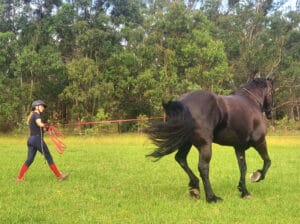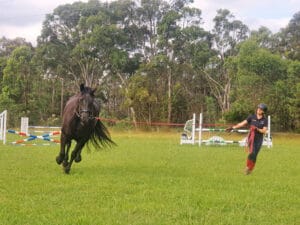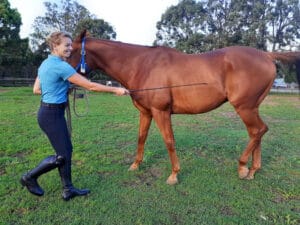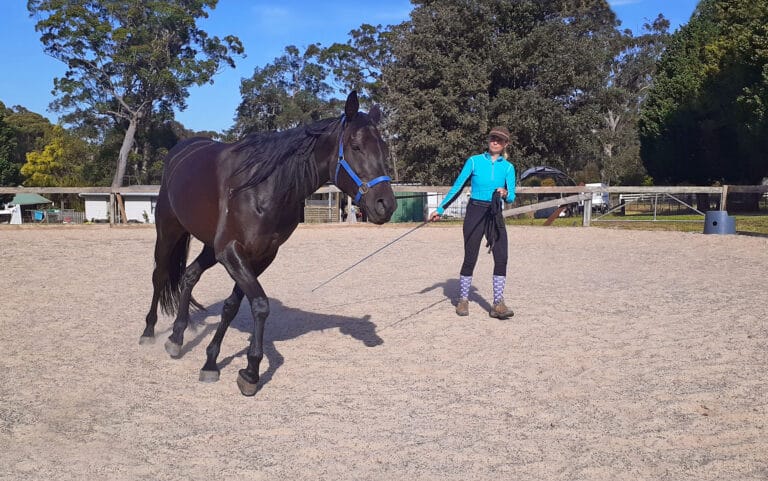If you work through the week and want to make the most of the little time you have with your horse, CHRISTINE ARMISHAW has a few clever hacks.
One way to save time but still get some quality work in is to do it from the ground. Here’s a selection of quick yet productive off-horse exercises to keep your horse’s mind engaged and fitness up. For safety, doing these exercises while wearing an approved helmet and a good pair of non-slip gloves is recommended.
Lunging with transitions
Lunging your horse is a great way to get some fitness work in, even if you don’t have time to ride. Some say lunging for 20 minutes is equivalent to an hour of ridden work, although that depends on what you are actually asking your horse to do! Letting a horse charge around on the end of the rope is not the goal here. You’re aiming for controlled work using the lunge rope and lunge whip (if required) as extensions of your arms.
Spend the first five minutes warming your horse up at a walk, including one rein-change during that time. If your horse thinks being lunged means running like a crazy horse, shorten the rope and walk alongside him to begin with, only increasing the length of rope between you if he is settled and calm.
From there, start to incorporate transitions between walk and trot. Transitions are a great way to build up your horse’s hindquarter strength as they require more effort to go up and down gears compared to running around in circles. Practising going forward and back between paces can also be beneficial for improving your horse’s ‘go’ aid while under saddle.
Spend anywhere from ten to fifteen minutes moving frequently between walk and trot and, if the footing and your horse’s temperament allows, also between trot and canter. The closer together you make transitions, the more effort is required from your horse. Change rein at least every two minutes to keep them working evenly on both sides.
And rather than standing in a fixed spot, be sure to keep yourself moving around on a smaller circle within the larger circle your horse is travelling along – your horse is less likely to place as much stress on the outside legs as might happen on a tight circle.

Aim for controlled work, using the lunge rope and whip as extensions of your arms.

After a five minute warm up, incorporate transitions between walk, trot and if possible, canter.
Object desensitisation
Working from the ground is a brilliant way to help your horse get over perceived scary things. Accustom them to new sensations with ropes, pool noodles, or a flag on a stick. A rope, which can fold up small and makes little sound, is generally the least offensive item, while pool noodles and flags take up space and can flap unexpectedly, which may be met with alarm. Select your item according to your horse’s sensitivity, and aim to build their confidence gradually. This can take minutes for some horses, days for others.
Start by letting them sniff the item you’ve chosen and look at it with both eyes. The goal is to rub it all over your horse’s body. A good place to start is at the shoulder, as horses generally tend to be more accepting of their shoulders being touched. Rub with the back of your hand, then rub with the item. All your movements should be quiet and calm. If the horse is accepting, take the item away and praise him. Or, if he wants to move, try and keep the item close to him until he stays still for a moment, then take it away. This is pressure-release: you are taking away pressure (the closeness of a new item) when he behaves as you want (standing still).
By way of approach and retreat, you can gradually build your horse up to quietly standing and allowing his body to be touched all over. Horses are often most uncomfortable with a new item touching their legs and head, so take special care around these areas. If it’s a lot for your particular horse, accept small wins and call it a day – you can always try again tomorrow. Patience and calmness is the only way to create a brave and confident partner.
Yielding the quarters
Another superb ground-based exercise is teaching your horse to move his hindquarters. This is a great exercise for teaching them to isolate and move their quarters when asked rather than their whole body, and is a great introduction for a variety of exercises you may want to do from the saddle.
Teaching your horse to yield can also improve suppleness in the hind end and is excellent for getting their attention and focus prior to mounting at the start of a ride. To give me an idea of where they’re at mentally and how they might be feeling, I do this with every horse prior to getting on.
The goal of this exercise is to ask the horse to step his inside hind leg across and in front of the outside hind leg as he moves his quarters away from you. Start by standing at your horse’s left shoulder. Using your right hand press your fingers into

For a hindquarter yield, stand at their left shoulder and apply your right hand or dressage whip just behind where your leg would be.

Apply pressure until your horse steps their inside hind leg across and in front of the outside hind leg.
your horse’s side, or tap with your dressage whip, just behind where your leg would be if you were in the saddle. At the same time, use your left hand to pull your horse’s head towards you slightly, making sure that the majority of pressure is coming from the hand or whip pushing against the flank.
Watching for movement of the inside hind leg, apply firm and consistent pressure until the horse takes one step across, at which point all your pressure stops. For clarification, your finger pressure should stay consistently on, or if using your whip it should tap steadily, until the horse takes one step. It’s important you don’t release the pressure too early, or remove it if the horse does something different, like a step behind the outside leg, or a small, shuffling side-step that doesn’t cross the outside leg. Likewise, it’s important to remove the pressure at the very moment they complete the correct action.
Repeat this for four steps, asking for just one step at a time with a moment of no pressure in between each step. Once your horse is comfortable and understands what is being asked, change sides and run through the entire process again from the right hand side.
You should find that as your horse grasps the concept of this exercise, the pressure or amount of tapping required gets less and less. Remember, always use as much fair pressure as necessary, while aiming to use the least amount possible to get the job done.
Feature Image: Lunging is a time saving off-horse exercise that can yield great benefits.



